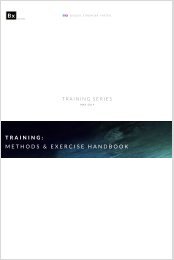Create successful ePaper yourself
Turn your PDF publications into a flip-book with our unique Google optimized e-Paper software.
HTKSPORT<br />
Therefore, we often refer to the absorption/rebound ability of the athlete as the<br />
“stiffness” of both the musculature and joints of the legs during sprinting (or other<br />
structures for other movements utilising the static spring). This is why a speed<br />
athlete’s strength foundation should incorporate contractile and absorption strength<br />
work. This is discussed further below.<br />
Another important discussion that stems from this is the type of strength training<br />
speed athletes should focus on. The specific section below “Strength for Speed<br />
Athletes” is useful for such athletes.<br />
2.2 Expressions of Physical Performance<br />
The next thing to understand, for functional performance at least, is that sports are<br />
rarely limited to a single performance output. American football, for example,<br />
requires explosive leg speed, varying degrees of upper and lower body strength and<br />
power, and body mass in order to be proficient at all the demands of the sport.<br />
Different positions demand varying degrees or combinations of each, but it is easy to<br />
see how understanding the continuum of physical outputs is the first step to<br />
designing an efficient training program. The next question is therefore one of<br />
recognising which sporting or physical demands require proficiency is which outputs.<br />
As mentioned above, the neuro-muscular inputs exist on a continuum, where<br />
different points along the continuum may be viewed as different contribution<br />
combinations of the various types of input. Similarly, specific physical performances<br />
may be characterised as combinations of inputs. Speed (as in sprint or running speed)<br />
is comprised of both MAG and RATE inputs – the fastest athletes across the ground<br />
are those who can apply the most force into the ground with every stride, with a fast<br />
stride rate – the most force, in the least time; i.e. track speed is a function of stride<br />
length (force into and rebounded from the ground, and stride frequency. It is also<br />
important to remember that the capacity of an athlete’s MAG potential is affected by<br />
their DUR training, because DUR training should increase their muscular and<br />
absorption force capacities (see ‘The Performance Loop” section below). Traditional<br />
strength, on the other hand, would be a combination of MAG and DUR – the MAG<br />
work would contribute to the ability to recruit a maximal number of muscle fibres,<br />
while the DUR work would represent the amount of time such recruitment can be<br />
sustained.<br />
15<br />
JUNE 2018 | ISSUE 01




